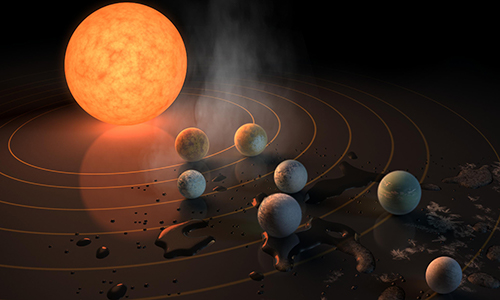|
|
|
|
|
|
| |
|
|
| |
UChicago planetary scientist Edwin Kite looks beyond Earth's example for alien life. |
|
| |
|
|
|
|
|
| |
|
|
| |
Follow the water. That's NASA's mantra when it comes to seeking out alien life. On Earth, wherever there is H2O--scalding thermal vents, frozen glaciers, highly alkaline or acidic geyser basins--there is life. The two are so highly correlated here, it makes sense to start the search for one where there's evidence of the other. But how much water is too much water? |
|
| |
|
|
|
| |
|
|
| |
For instance, the fifth exoplanet in the TRAPPIST-1 system has liquid water an estimated 200 km deep, 20 times deeper than Earth's Mariana Trench. That depth of water would maintain an ice layer on the ocean bed, which might interfere with the carbon-silicate cycle, a geochemical process that moves carbon dioxide between Earth's atmosphere and mantle, stabilizing our climate. Some scientists think such interference would prohibit long-term habitability on water worlds. |
|
| |
|
|
|
| |
|
|
| |
|
|
| |
| |
|
|
| |
TRAPPIST-1, an ultra-cool dwarf star 39 light years away toward the constellation Aquarius, has seven Earth-like (in size, mass, and composition) exoplanets in orbit. Two are 50 percent water; two are about 15 percent water. Earth, for reference, is 0.1 percent wet. (Image courtesy NASA/JPL-Caltech) |
|
| |
|
|
|
|
| |
|
|
|
| |
|
|
| |
But UChicago planetary scientist Edwin Kite says relying on Earth as the analogy for habitability elsewhere in the universe is inadequate. Instead, he thinks researchers should begin with basic chemistry and physics to determine what is possible and what is probable for exoplanet habitability. |
|
| |
|
|
|
| |
|
|
| |
For instance, Kite and Penn State astrophysicist Eric Ford suspect carbon dioxide could cycle between the atmosphere and the ocean itself. They think a massive ocean is beneficial because it would serve as a reservoir to store excess greenhouse gas. From more than a thousand simulations, they conclude that about 10 percent of such water worlds could have a habitable climate for over a billion years--long enough for life to arise. |
|
| |
|
|
|
| |
|
|
| |
Kite has also considered the worry that abundant water (compared to Earth) would prevent organisms from obtaining nutrients from rock, such as the phosphorus that forms DNA's backbone. He suggests nutrients might arrive through unexpected means, such as asteroid collisions. |
|
| |
|
|
|
| |
|
|
| |
Assessing an exoplanet's potential for habitability is important so researchers can narrow down candidates when deciding where to direct telescopes or send space missions for further investigation. And there are a lot of candidates: research suggests that water worlds are far more abundant in the galaxy than rocky, slightly damp planets like Earth. |
|
| |
|
|
|
|
|
|
|
|
|
|
|
| |
|
|
| |
|
|
|
| Whether the "snowball Earth" fate is good or bad for life's origin and evolution is unclear, but planets can avoid it by being tilted and tidally locked. |
|
|
|
| |
|
|
|
|
|
|
|
|
|
| |
|
|
| |
|
|
|
| Mars used to have rivers, but they don't make sense. |
|
|
|
| |
|
|
|
|
|
|
|
|
|
| |
|
|
| |
|
|
| |
| |
|
|
| |
Martian bedrock resembles dragon scales in this photo taken by the High Resolution Imaging Science Experiment camera. (Photo courtesy NASA/JPL/University of Arizona) |
|
| |
|
|
|
|
| |
|
|
|
| |
|
|
| |
In 2005 the Mars Reconnaissance Orbiter headed toward the red planet carrying six instruments, including the High Resolution Imaging Science Experiment (HiRISE), the most powerful camera ever sent to another planet. |
|
| |
|
|
|
| |
|
|
| |
Twelve years later, HiRISE took a photograph of Mars's surface, and the false color image reveals an interesting texture: dragon scale. The appearance was caused by water interacting with bedrock to form clay. Then surface erosion exposed the pinkish "scales." The nature of the water and how the bedrock actually turned into clay remain a mystery, one that, if solved, would help scientists understand the planet's past climate and whether it could have supported life. |
|
| |
|
|
|
|
|
|
|
|
|
| |
|
|
| |
Dark dawdler:
Physicists propose using the Large Hadron Collider to detect "slow" dark particle.
|
| |
|
|
|
|
| |
Wanted:
Do you know this math-minded rat? Reward for info leading to the identity of the Reg Rat illustrator.
|
| |
|
|
|
|
|
|
|
|
|
|
| |
|
|
| |
| |
|
|
| |
Good things come to those who share! Forward µChicago to a friend and be entered to win a prize. Congratulations to last month's contest winner, Katherine Reyes.
Sign up to receive µChicago monthly. |
|
| |
|
|
|
|
| |
|
|
|







